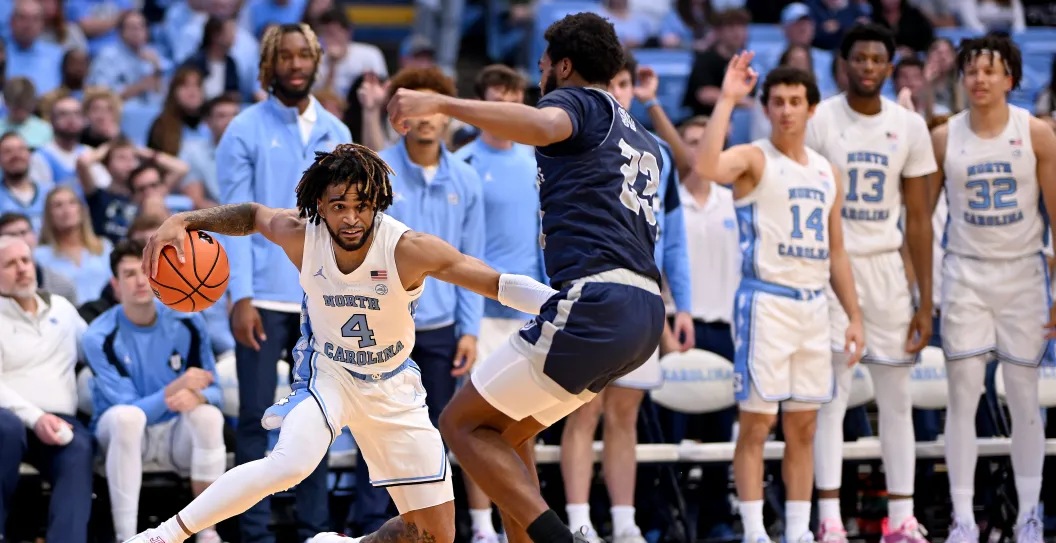In the second half of North Carolina's exhibition basketball game against Saint Augustine's on Oct. 27, referee Bill Covington Jr. faced a problem not seen in college basketball in more than seven decades.
Videos by FanBuzz
Trailing by 41 points with just over 11 minutes to play, St. Aug's guard Kaleb Glasper dribbled around a screen. His defender, Tar Heel Paxson Wojcik, tried to follow without giving ground. He squeezed past the screen and thrust his hips into Glasper as he tried to keep a body in front of him.
It was a foul. Covington blew the whistle.
Then came the dilemma for the official. He needed to signal to the scorer's table who the foul was on, but he only had five fingers on his right hand. And Wojcik, a new Tar Heel via a transfer, wore the No. 8 on his blue-and-white UNC jersey.
Covington flashed both hands in front of him, five fingers on one and three on the other. "Eight," he yelled to the table.
Granted, it wasn't the most insurmountable problem in the world, but it still was a new one for NCAA referees.
In the early 1950s, the NCAA passed Rule 1, Section 22, Article 7, Clause b.2. It banned digits greater than 5 on basketball jerseys. The rationale was that referees needed to be able to signal fouls to the scorer's table using their hands. The right hand would show the first digit of the player's number and the left would show the second. So, in the case of Wojcik's foul, Covington's signal would normally mean the foul would be charged to player No. 53.
As the rule read in the official NCAA book:
"The following numbers are legal: 0, 1, 2, 3, 4, 5, 00, 10, 11, 12, 13, 14, 15, 20, 21, 22, 23, 24, 25, 30, 31, 32, 33, 34, 35, 40, 41, 42, 43, 44, 45, 50, 51, 52, 53, 54, and 55. Team rosters can include 0 or 00, but not both."
The NBA, on the other hand, has no such rule. Kobe Bryant wore No. 8 for much of his career. Bill Russell and Dr. J wore No. 6. George Mikan was No. 99. Dennis Rodman, for a time, was No. 91. Referees were able to successfully call fouls on each of them.
This past summer, the NCAA decided to loosen things up, making a number of changes to player appearance rules. Teams now don't need to apply for a special waiver if a player wants to wear some type of religious headgear on the floor. It's just permitted. School and player names can now be spelled out in a circular pattern, although it remains to be seen if any schools will adopt that design.
And good old Rule 1.22.7.b.2 has been drastically simplified:
"The following numbers are legal: 0-99. Team rosters can include 0 or 00, but not both."
There wasn't a groundswell of demand for the rule to be changed. And thus far, college basketball seems slow to make use of it. Only a handful of players have chosen previously illegal digits.
The teams in the AP Top 25 have a total of 12 players who have high-digit uniform numbers, including UNC's Wojcik, who wore No. 0 with Loyola Chicago last year. He is the first Tar Heel to wear No. 8 since Dick Patterson in 1951. His teammate, Seth Trimble, wore No. 0 as a freshman with the Tar Heels last year but has changed to No. 7, the first Heel since Simon Terrell in 1950 to wear that number.
"Eight's always been my lucky number," Wojcik said. "I was born 8/8, August 8th. It's the first year we can do it, and it's my last year, so I said, 'Why not?'"
Across the power conferences, only 43 players have taken advantage of the rule. That includes USC's Bronny James, who will wear No. 6, his dad's number with the Heat. Of that group, 39 players opted for single-digit numbers: No. 7 was the most popular, with 12 players choosing it. Eleven went with No. 8, and 10 players chose No. 9. The least popular single-digit numbers was No. 6, with just a half-dozen players wearing it.
The four players who chose previously outlawed double-digit numbers were Xavier's Lazar Djokovic (No. 17) and UCLA's Jan Vide (No. 27), both freshmen; Arizona's Keshad Johnson (No. 16), a transfer who wore No. 0 with San Diego State; and Missouri's Connor Vanover, the only player to choose a number greater than the previous maximum, 55. After wearing No. 23 at Arkansas and No. 35 at Oral Roberts, Vanover will wear No. 75 with the Tigers this year.
Referees will have to make the adjustment, and official scorers will have to take greater care as we move toward a world with unregulated uniform numbers.
Unless teammates want to wear No. 0 and double-0, of course. That last hurdle remains.
